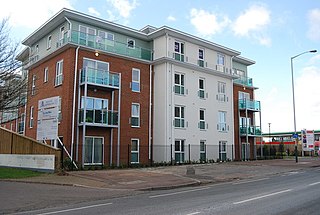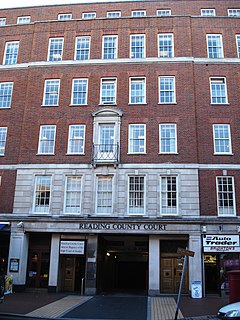
In Ireland and the United Kingdom, housing associations are private, non-profit making organisations that provide low-cost "social housing" for people in need of a home. Any budget surplus is used to maintain existing housing and to help finance new homes and it cannot be used for personal benefit of directors or shareholders. Although independent, they are regulated by the state and commonly receive public funding. They are now the United Kingdom's major providers of new housing for rent, while many also run shared ownership schemes to help those who cannot afford to buy a home outright.
A leasehold estate is an ownership of a temporary right to hold land or property in which a lessee or a tenant holds rights of real property by some form of title from a lessor or landlord. Although a tenant does hold rights to real property, a leasehold estate is typically considered personal property.
Housing Benefit is a means-tested social security benefit in the United Kingdom that is intended to help meet housing costs for rented accommodation. It is the second biggest item in the Department for Work and Pensions' budget after the state pension, totalling £23.8 billion in 2013–14.
Local Housing Allowance (LHA) was introduced on 7 April 2008 to provide Housing Benefit entitlement for tenants renting private-sector accommodation in England, Scotland and Wales. The LHA system introduced significant changes to the way Housing Benefit (HB) levels are restricted and how benefit is paid. It did not replace Housing Benefit - it is just a different way of calculating entitlement under the existing Housing Benefit scheme: the Local Housing Allowance is based on the 30th percentile of local rented accommodation, while the 50th percentile or median was used from the introduction of the policy until 2011. LHA rates relate to the area in which the housing-benefit claim is made. These areas are called "Broad Rental Market Areas", defined as "where a person could reasonably be expected to live taking into account access to facilities and services", and a selection of rents in the area are used to determine the LHA for each category of housing in the area.

A house in multiple occupation (HMO), or a house of multiple occupancy, is a British English term which refers to residential properties where ‘common areas’ exist and are shared by more than one household.
The assured shorthold tenancy (AST) is the default legal category of residential tenancy in England and Wales. It is a form of assured tenancy with limited security of tenure, which was introduced by the Housing Act 1988 and saw an important default provision and a widening of its definition made by the Housing Act 1996. Since 28 February 1997 in respect of accommodation to new tenants who are new to their landlords, the assured shorthold tenancy has become the most common form of arrangement that involves a private residential landlord. The equivalent in Scotland is short assured tenancy.
A damage deposit or deposit is a sum of money paid in relation to a rented item to ensure it is returned in good condition. They are particularly common in relation to rented accommodation, where they may also be referred to as a tenancy deposit, bond deposit, or bond.

An assured tenancy is a legal category of residential tenancy to an individual in English land law. Statute affords a tenant under an assured tenancy a degree of security of tenure. A tenant under an assured tenancy may not be evicted without a reasonable ground in the Housing Act 1988 and, where periodic changes in rent are potentially subject to a challenge before a rent assessment committee.
The Landlord and Tenant Act 1985 is a UK Act of Parliament on English land law. It sets bare minimum standards in tenants' rights against their landlords.
A Section 8 notice, also known as the Section 8 notice to quit or Form 3. It is a prerequisite if the landlord of an assured tenancy or assured shorthold tenancy wishes to obtain possession order from the court, thereby ending the tenancy, for a reason based on a circumstance entitling the landlord to possession under the grounds pleaded. It is used in England and Wales and is part of the Housing Act 1988. as amended by the Housing Act 1996.
The history of rent control in England and Wales is a part of English land law concerning the development of rent regulation in England and Wales. Controlling the prices that landlords could make their tenants pay formed the main element of rent regulation, and was in place from 1915 until its abolition by the Housing Act 1988.
In England and Wales, a section 21 notice, also known as a section 21 notice of possession or a section 21 eviction, is the notice which a landlord must give to their tenant to begin the process to take possession of a property let on an assured shorthold tenancy without providing a reason for wishing to take possession. The expiry of a section 21 notice does not bring a tenancy to its end. The tenancy would only be ended by a landlord obtaining an order for possession from a court, and then having that order executed by a County Court bailiff or High Court enforcement officer. Such an order for possession may not be made to take effect earlier than six months from the beginning of the first tenancy unless the tenancy is a demoted assured shorthold tenancy. If the court is satisfied that a landlord is entitled to possession, it must make an order for possession, for a date no later than 14 days after the making of the order unless exceptional hardship would be caused to the tenant in which case possession may be postponed to a date no later than six weeks after the making of the order. The court has no power to grant any adjournment or stay of execution from enforcement unless the tenant has a disability discrimination, public law or human rights defence, or the case is pending an appeal.
Rent control in Scotland is based upon the statutory codes relating to private sector residential tenancies. Although not strictly within the private sector, tenancies granted by housing associations, etc., are dealt with as far as is appropriate in this context. Controlling prices, along with security of tenure and oversight by an independent regulator or the courts, is a part of rent regulation.
A short assured tenancy is a type of tenancy in Scotland that was introduced by the Housing (Scotland) Act 1988. A short assured tenancy gives landlords some protection and freedom of action when letting their properties. Short assured tenancies have become the norm within the residential letting industry in Scotland. The equivalent legislation in England and Wales is assured shorthold tenancy. Following the enactment of the Private Housing (Tenancies) (Scotland) Act 2016, it is no longer possible to create a short assured tenancy, instead a private residential tenancy must be entered into; with greater protections for the tenant such as security of tenure.
The Welfare Reform Act 2012 is an Act of Parliament in the United Kingdom which makes changes to the rules concerning a number of benefits offered within the British social security system. It was enacted by the Parliament of the United Kingdom on 8 March 2012.
A sitting tenant is a tenant already in occupation of premises, especially when there is a change of owner. Sitting tenants can result from a decision not to evict an assured shorthold tenant following a change of owner or where there is a protected tenancy. Where a landlord sells a property but decides not to evict a tenant the new landlord is said to 'step in the shoes' of the old landlord and the terms of the tenancy continue.

Rent regulation is a system of laws, administered by a court or a public authority, which aims to ensure the affordability of housing and tenancies on the rental market for dwellings. Generally, a system of rent regulation involves:
The under-occupancy penalty results from a reform contained in the British Welfare Reform Act 2012 whereby tenants living in public housing with rooms deemed "spare" face a reduction in Housing Benefit, resulting in them being obliged to fund this reduction from their incomes or to face rent arrears and potential eviction by their landlord. The under-occupancy penalty is more commonly referred to as the Bedroom Tax; especially by critics of the changes who argue that they amount to a tax because of the lack of social housing for affected tenants to downsize to.
A revenge eviction is a term used in the United Kingdom to describe an eviction process initiated by a landlord where a tenant asks for repairs to be carried out or complains about conditions. Campaign groups such as Shelter have called for revenge evictions to be legislated against.
The Housing and Planning Act 2016 is Act of Parliament in the United Kingdom that makes widespread changes to housing policy and the planning system. It introduces legislation to allow the sale of higher value local authority homes, introduce starter homes and "Pay to Stay" and other measures intended to promote home ownership and boost levels of housebuilding. The Act has been subject to a number of criticisms by those opposed to the loss of social housing promoted, the extension of right-to-buy to housing associations and possible work disincentives under "Pay to Stay".



